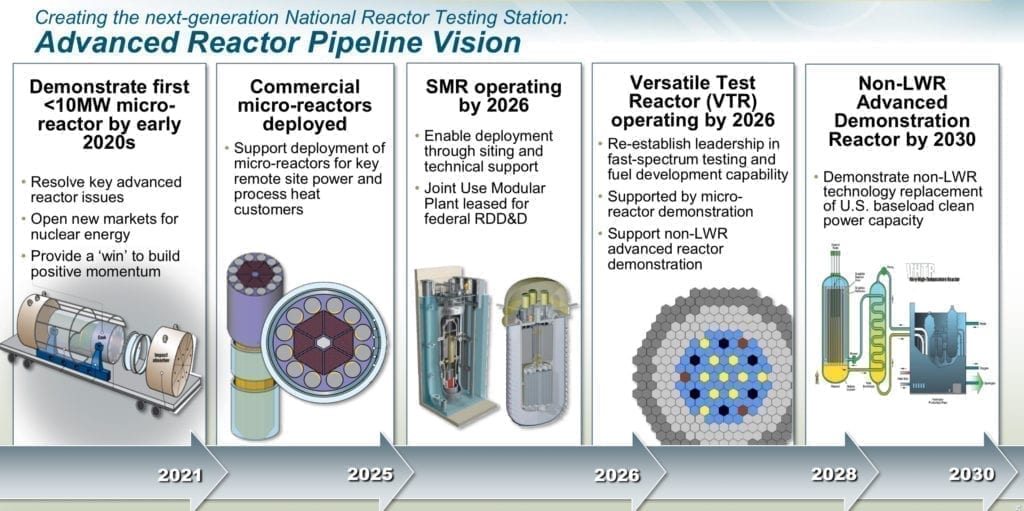Bolstered by $230 million in Congressionally appropriated funding, the Department of Energy (DOE) has officially launched the Advanced Reactor Demonstration Program (ARDP) to help U.S.-based private developers of advanced nuclear reactors demonstrate their technology in the U.S.
Much anticipated by industry, the program formally established under the Office of Nuclear Energy program on May 14 is one of three major government-led and Congressionally supported initiatives to boost U.S. nuclear energy research and development. Congress has also appropriated $305 million for fuel cycle research and development, and $267 million for reactor concepts research, including for the industry-ledAdvanced Reactor Conceptsprogram and theVersatile Advanced Test Reactor.
 The National Reactor Innovation Centerat Idaho National Laboratory provides resources for testing, demonstration, and performance assessment to accelerate deployment of new advanced nuclear technology concepts. These are some milestones and a tentative timeline the facility could achieve over the next decade. Source: INL
The National Reactor Innovation Centerat Idaho National Laboratory provides resources for testing, demonstration, and performance assessment to accelerate deployment of new advanced nuclear technology concepts. These are some milestones and a tentative timeline the facility could achieve over the next decade. Source: INLTo begin with, ARDP will provide $160 million in the first year of funding to industry to build two reactors that can be operational within the next five to seven years. The ARDP also seeks to leverage the National Reactor Innovation Center (NRIC) to allow developers to test and assess their technologies, the DOE said.
Major Funding Opportunity
To kick off the program, the DOE on Thursday also issueda funding opportunity announcement (FOA)with a $4 billion award ceiling that comprises several separate approaches that could essentially support up to seven advanced reactor projects, and subsidize their adoption over the next 15 years.
The FOA says the ARDP’s overarching goal is to focus public and private resources on “the actual construction of real demonstration reactors that aresafe and affordable to build in the near- to mid-term.” To achieve that, it outlines two separate pathways.
One pathway will support actual demonstrations of two reactors within the next five to seven years. The other will seek to reduce risks for future demonstrations, supporting between two and five other “diverse advanced reactor designs” that have a commercialization horizon that is five years longer than the advanced reactor demonstration.
A third pathway, meanwhile, is outlined inH.R. 1865, a Congressional appropriations document, and it calls for the development of at least twoat least two new public-private partnership awards focused on advancing reactor designs toward the demonstration phase. These projects will have a commercialization horizon that is approximately five years longer than the Risk Reduction for Future Demonstration awards.
Made in the U.S.A
Eligible applicants for the FOA, which is set to close on Aug. 12, 2020, include all “interested U.S. sources (other than individuals), including nuclear industry entities (e.g., reactor vendors, fuel manufacturers, utilities and power producers, supply chain vendors, engineering, procurement, and construction contractors, etc.), companies using non-electric power from reactors, universities, and/or teams/consortia capable of designing, building, and operating an advanced nuclear reactor demonstration.”
The DOE, however, notes that applicants must submit information to show that they are not owned, controlled, or dominated by an alien, a foreign corporation, or a foreign government.
In a statement introducing the ARDP, Energy SecretaryDan Brouillette pointed torecent findings by the White House Nuclear Fuel Working Group’s April 23 report, which laid out a strategy for theU.S.to regain its international standing as a world leader in nuclear energy. The strategy will essentially seek to strengthen the full domestic nuclear fuel cycle, possibly deny imports of nuclear fuel fabricated in Russia or China, and promote advanced reactor technologies.
“The next generation of nuclear energy is critical to our Nation’s energy security and environmental stewardship,” Brouillette said. “As the recently released Nuclear Fuel Working Group’s Strategy to Restore American Nuclear Energy Leadership exemplifies, we must pursue technological innovation and advanced nuclear RD&D investments to strengthen American leadership in the next generation of nuclear technologies, ensuring a healthy and growing U.S. nuclear energy sector.”
Separately,Dr. Rita Baranwal, the recently appointed assistant secretary for the Office of Nuclear Energy, highlighted nuclear’s environmental benefits. “Advanced nuclear energy systems hold enormous potential to lower emissions, create new jobs, and build a strong economy,” she said. “This new program creates a tremendous opportunity for the U.S. to provide clean energy and expand our market opportunities.”
 (20min delay)
(20min delay)




